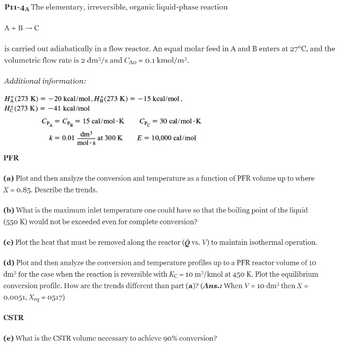
Introduction to Chemical Engineering Thermodynamics
8th Edition
ISBN: 9781259696527
Author: J.M. Smith Termodinamica en ingenieria quimica, Hendrick C Van Ness, Michael Abbott, Mark Swihart
Publisher: McGraw-Hill Education
expand_more
expand_more
format_list_bulleted
Question

Transcribed Image Text:(f) The reaction is next carried out in a 25 dm3 batch reactor charged with NAO = 10 moles. Plot the
number of moles of A, NA, the conversion, and the temperature as a function of time.

Transcribed Image Text:P11-4A The elementary, irreversible, organic liquid-phase reaction
A + B → C
is carried out adiabatically in a flow reactor. An equal molar feed in A and B enters at 27°C, and the
volumetric flow rate is 2 dm³/s and CÃO = 0.1 kmol/m³.
Additional information:
H(273 K) = -20 kcal/mol, Hg (273 K) = -15 kcal/mol,
He(273 K) = -41 kcal/mol
CPA = CP₂ = 15 cal/mol. K
k = 0.01
dm³
mol.s
at 300 K
PFR
Cpc = 30 cal/mol - K
E = 10,000 cal/mol
(a) Plot and then analyze the conversion and temperature as a function of PFR volume up to where
X = 0.85. Describe the trends.
(b) What is the maximum inlet temperature one could have so that the boiling point of the liquid
(550 K) would not be exceeded even for complete conversion?
(c) Plot the heat that must be removed along the reactor (O vs. V) to maintain isothermal operation.
(d) Plot and then analyze the conversion and temperature profiles up to a PFR reactor volume of 10
dm³ for the case when the reaction is reversible with Kc = 10 m³/kmol at 450 K. Plot the equilibrium
conversion profile. How are the trends different than part (a)? (Ans.: When V = 10 dm³ then X =
0.0051, Xeq = 0517)
CSTR
(e) What is the CSTR volume necessary to achieve 90% conversion?
Expert Solution
This question has been solved!
Explore an expertly crafted, step-by-step solution for a thorough understanding of key concepts.
This is a popular solution
Trending nowThis is a popular solution!
Step by stepSolved in 3 steps with 28 images

Knowledge Booster
Similar questions
- Consider the following potential energy diagram: * 1 p Reaction A Reaction B potential potential energy energy Reaction Pathway Reaction Pathway Reaction A is exothermic while Reaction B is endothermic Reaction A is endothermic while Reaction B is exothermic Reaction A will most likely be spontaneous while Reaction B is unlikely to be spontaneous O Reaction A releases heat while Reaction B absorbs heatarrow_forwardQUESTION IN IMAGEEarrow_forwardavoid typing the answers and kindly answer the questionarrow_forward
- 1. The reaction A → B is to be carried out isothermally in a continuous-flow reactor. The entering volumetric flow rate (v.) is 8 L/h. For a constant volumetric flow rate v = Do, then FA CAVO Also, CAO FAO/vo. Pure species A enters into the reactor at a rate of 4 mol/h. Calculate both the CSTR and PFR volumes necessary to consume 99% of species A (i.e., CA = 0.01CAo) assuming the reaction rate -гA is a. -TAKA with kA = 0.05 mol/L.h b. rA KACA with kA = 0.0001 s¨¹ C. -TA KA(CA)² with kA = 300 L/mol.h 2. Repeat parts a, b, and c above to calculate the time necessary to consume 99.9% of species A in a 1,000 L constant-volume batch reactor with CA。 = 0.5 mol/L.arrow_forward5. [ , The isothermal and isobaric gas phase reaction: A → 2B follows an elementary rate law. The rate constant k = 1.5 s' when the reaction temperature is at T = 350 K. Pure A is fed into a continuous-stirred tank reactor (CSTR) at a volumetric flow rate of 5 dm/s. What conversion of A can the reactor achieve if the reactor has a volume of 20 dm?arrow_forwardPlease correct answer and don't use hand ratingarrow_forward
arrow_back_ios
arrow_forward_ios
Recommended textbooks for you
 Introduction to Chemical Engineering Thermodynami...Chemical EngineeringISBN:9781259696527Author:J.M. Smith Termodinamica en ingenieria quimica, Hendrick C Van Ness, Michael Abbott, Mark SwihartPublisher:McGraw-Hill Education
Introduction to Chemical Engineering Thermodynami...Chemical EngineeringISBN:9781259696527Author:J.M. Smith Termodinamica en ingenieria quimica, Hendrick C Van Ness, Michael Abbott, Mark SwihartPublisher:McGraw-Hill Education Elementary Principles of Chemical Processes, Bind...Chemical EngineeringISBN:9781118431221Author:Richard M. Felder, Ronald W. Rousseau, Lisa G. BullardPublisher:WILEY
Elementary Principles of Chemical Processes, Bind...Chemical EngineeringISBN:9781118431221Author:Richard M. Felder, Ronald W. Rousseau, Lisa G. BullardPublisher:WILEY Elements of Chemical Reaction Engineering (5th Ed...Chemical EngineeringISBN:9780133887518Author:H. Scott FoglerPublisher:Prentice Hall
Elements of Chemical Reaction Engineering (5th Ed...Chemical EngineeringISBN:9780133887518Author:H. Scott FoglerPublisher:Prentice Hall
 Industrial Plastics: Theory and ApplicationsChemical EngineeringISBN:9781285061238Author:Lokensgard, ErikPublisher:Delmar Cengage Learning
Industrial Plastics: Theory and ApplicationsChemical EngineeringISBN:9781285061238Author:Lokensgard, ErikPublisher:Delmar Cengage Learning Unit Operations of Chemical EngineeringChemical EngineeringISBN:9780072848236Author:Warren McCabe, Julian C. Smith, Peter HarriottPublisher:McGraw-Hill Companies, The
Unit Operations of Chemical EngineeringChemical EngineeringISBN:9780072848236Author:Warren McCabe, Julian C. Smith, Peter HarriottPublisher:McGraw-Hill Companies, The

Introduction to Chemical Engineering Thermodynami...
Chemical Engineering
ISBN:9781259696527
Author:J.M. Smith Termodinamica en ingenieria quimica, Hendrick C Van Ness, Michael Abbott, Mark Swihart
Publisher:McGraw-Hill Education

Elementary Principles of Chemical Processes, Bind...
Chemical Engineering
ISBN:9781118431221
Author:Richard M. Felder, Ronald W. Rousseau, Lisa G. Bullard
Publisher:WILEY

Elements of Chemical Reaction Engineering (5th Ed...
Chemical Engineering
ISBN:9780133887518
Author:H. Scott Fogler
Publisher:Prentice Hall


Industrial Plastics: Theory and Applications
Chemical Engineering
ISBN:9781285061238
Author:Lokensgard, Erik
Publisher:Delmar Cengage Learning

Unit Operations of Chemical Engineering
Chemical Engineering
ISBN:9780072848236
Author:Warren McCabe, Julian C. Smith, Peter Harriott
Publisher:McGraw-Hill Companies, The